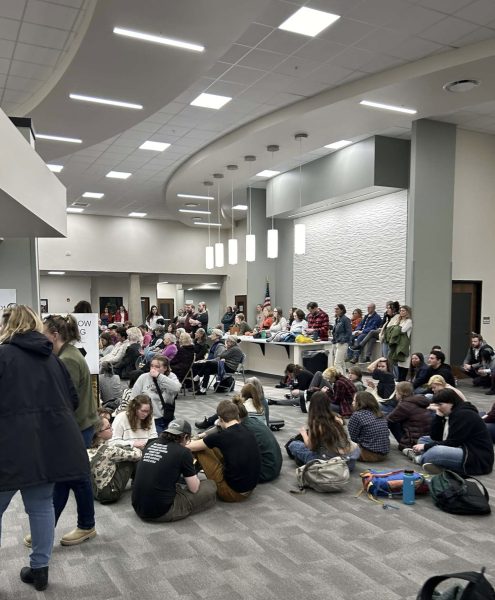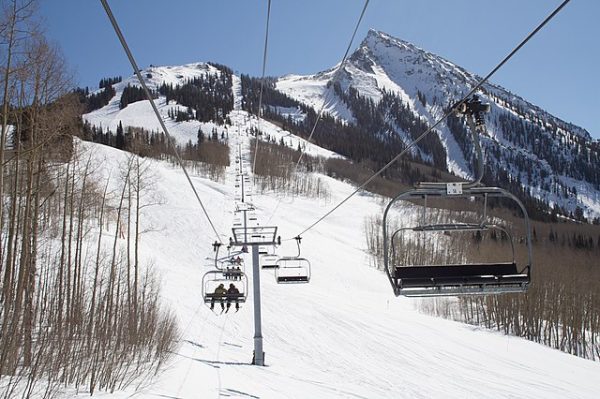Hellgate Introduces Controversial ‘Yellow Line’
Right off the heels of summer, students shuffled into Hellgate, ready to begin another year. And though in a new grade, many students were excited to see their same friends, play the same sports and hang out in the same hallways. Upon returning (or arriving) to Hellgate, however, it became increasingly apparent that this last inclination would soon be a thing of the past. That’s because Hellgate had introduced a new policy, requiring students to remain behind a set of yellow lines during lunch, containing them to the Commons area (see diagram).
Getting past the yellow line in order to see teachers, use lockers, or be in a classroom now require students to carry a pass signed by a teacher or administrator. The rule, quickly dubbed the ‘Yellow Line Policy’, which had been announced during a school-wide assembly was met with immediate backlash from students.
Kihla Lax (freshman) said she doesn’t like the policy because “it feels a lot like middle school.” She continues to say, “I was expecting to have a little bit more freedom throughout the school so I [could] take charge of what I need to for academics.” So why was the policy introduced?
According to Hellgate principle, Judson Miller, the yellow line was introduced because of four reasons. “The first reason,” said Miller, “is the custodial time that it took to clean up the building. The second reason is that teachers, by contract, are afforded a duty-free lunch period. The third reason is student safety and supervision. [Lastly] the new kitchen, the new commons, the new bathrooms, the new Knight Hall, the new library and the new computer lab will all be open during lunches.”
He went on to say, “Yeah you have to stay in the yellow lines but we just spent $20 million building a new student center. We made your space infinitely better, now we’re just asking that you stay in that space.” Though the rule has solved these four concerns, it has also caused unintended consequences, namely with student participation in clubs and office hours.
With regard to office hours, English teacher Lewis Procacci said, “I think it cuts down the spontaneity of it. They might have passed a door and say, ‘I forgot, I wanted to ask Mr. Pro this’. I think both students and teachers will have to be more proactive and mindful of what you’re going to do.”
Despite this, Procacci believes that the policy is still beneficial. “I think it’s helpful,” he said. “I think it was difficult for the few administrators to handle the school the way it was set up before. But obviously, there’s going to be some growing pains until a better hall pass system is set up.”
As for clubs, many groups have noticed a lower turnout due to the inability to get to the meetings once lunch begins. Calvin Beighle (junior) is a member of multiple clubs and thinks that the yellow line has had a negative impact on participation. He stated that the current system is “affecting students’ involvement drastically.”
However, he notes that students are still able to get to their clubs if they go during the passing period between fourth period and lunch. “I think that, though this system has many kinks at this point and, in some ways, has been considered oppressive, there are ways to be involved in activities during lunch,” said Beighle.
One solution that’s been offered is the possibility of using the lower gym for clubs and activities during lunch. The idea has been suggested by both clubs and Mr. Miller himself, who said, “As long as student groups are being actively supervised by an advisor, it’s good.”
Clubs such as NHS have already begun experimenting with this by hosting meetings here, effectively separating the school from the gym during lunch. However, closing the gym for clubs raises safety concerns come winter-time when more students will be forced indoors. According to Chapter 10 of International Fire Code, each person in Hellgate’s commons is required to have at least 15 square feet of standing room; however, without the gym, the allotted space would only be able to host up to 75% of the student body before becoming a fire hazard.
While administration believes the yellow line is the best approach for the future, they have been met with heavy disdain from the student body. Students certainly miss their freedom to the school, though their agitations also stem from real concerns about student activities, clubs, and safety. Nonetheless, Hellgate’s yellow line policy is a direct response to its own concerns which have yet to be addressed by any other proposed solutions.
Discussions on the policy and its implementation are ongoing between student government and the administration. To voice your opinions on the matter, attend a meeting, Wednesdays at lunch in room 291.









